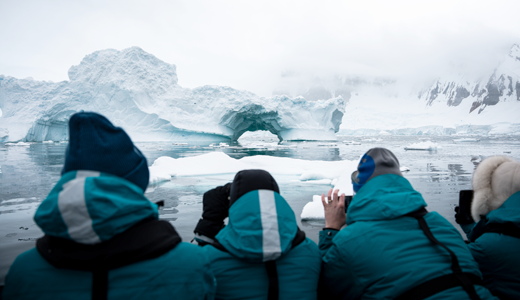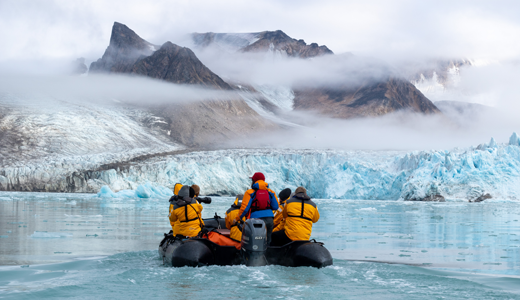Antarctica by Month: What to see and experience throughout the season
By Maysa Santoro l Epic Polar’s Photographer and explorer

Expert Insights with a personal touch
Antarctica is not just a destination, it is a dream for those drawn to the edge of the world. Unlike most places on the planet, it is not accessible year round. The best time to visit is during the austral summer, from November through March, when the sea ice recedes, wildlife activity reaches its peak, and the White Continent unveils its most breathtaking and dramatic landscapes.
This remote environment is shaped by powerful ocean currents, relentless winds, and most notably the shifting hours of daylight, which vary dramatically throughout the season. That’s why each month offers something truly unique: from untouched ice formations to curious penguins and migrating whales putting on a show just beyond your balcony. With over 40 years of combined experience in polar travel we’re here to guide you through what each part of the season has to offer, helping you choose the perfect window for your once in a lifetime expedition.
November: Early season awakening
Ocean ice is still thick in the early season, creating pristine, dramatic landscapes with towering icebergs and untouched expanses of white. As the days grow steadily longer, penguin colonies — including Gentoo, Chinstrap, and Adélie species — return to shore to begin nest building and courtship rituals. You may witness fascinating behaviors like stone stealing, mating displays, and the first eggs appearing in nests. Fur seals and Weddell seals become more active, and while whale sightings are fewer than later in the season, early arrivals can sometimes be spotted as they begin to feed in the nutrient-rich Antarctic waters. With striking icy scenes and vibrant wildlife activity, this is a photographer’s dream and a powerful time to witness the raw, early awakening of the continent

December to January: peak wildlife season
The heart of the season brings nearly 24 hours of daylight and milder temperatures by Antarctic standards. That means you can spot wildlife at any time of the day or night! Wildlife is fully alive: penguin chicks commence hatching in January, skuas hunt over rookeries, and parents diligently tend to young Adélie, Gentoo, and Chinstrap chick. Whale sightings intensify as humpback, minke, orca and other species feed around the Peninsula. Cloudless skies and long days are ideal for photography, kayaking, and Zodiac cruises.
Pro tip from Maysa: "If you're traveling during this time of the season, I highly recommend choosing a cabin with a balcony, especially if you're like me and don’t want to miss a single moment while you're there! It allows you to step outside anytime, even at "night", to take in the scenery. Also, if you can, opt for a cabin on the 4th floor — from my experience, it puts you at eye level with the wildlife, making the encounters feel much more intimate."

February to early March: whale watching and changing landscapes
As the Austral summer progresses, Antarctica enters one of its most dynamic phases. By February, much of the sea ice has melted, granting deeper access to remote landing sites and rarely visited bays. This is peak season for whale watching: humpbacks, minkes, and even orcas are frequently spotted in large numbers, often feeding near the ship, zodiacs, or even kayaks. Penguin colonies are bustling with activity as chicks begin to fledge, learning to swim and venture into the open sea. In South Georgia and the Falklands, you may witness seal pups growing more curious and active within the colonies.
The landscape begins to transform. Glaciers often calve with thunderous cracks into the sea, offering unforgettable front-row spectacles. The longer twilight hours cast golden and crimson hues across the ice, and on rare occasions, lucky travelers may catch a glimpse of the elusive Aurora Australis dancing along the horizon. It's a time of vibrant life, stunning contrasts, and powerful transitions: a favorite for photographers and wildlife lovers alike.

Late March: quiet, dramatic, rewarding
This is peak humpback whale season, the moment whale lovers dream of. If seeing this species of whale is at the top of your list, this is the time to come.
But the magic goes beyond the visuals. One of the most moving parts of this experience, meaning something no blog or video can capture, is the sound: listening to their powerful, rhythmic breathing echo across the water. It’s like a natural orchestra that plays just for you, hour after hour!

Each month has its charm
That being said, we like to say that from our perspective, there’s no single perfect month to visit Antarctica, only the perfect moment for you. Many travelers choose mid‑December through January for peak wildlife activity and milder weather, but every part of the season holds its own quiet magic. We’re here to guide you through the details so you can step onto the ice with clarity and excitement, fully present for the wonder that unfolds.
Reach out to plan your tailor‑made Antarctic journey anytime between November and March. Together, we’ll align your travel window with the wildlife encounters and moments that speak to your soul.
Bon voyage,
The Epic Polar Team

Written by: Maysa Santoro (instagram @maysasantoro)
Biologist, photographer, expedition leader and content creator.





